
The landscape of northern Spain erupted with jagged peaks and rolled along lush green hillsides. Farms folded across every nook, and waves pounded the Atlantic coast. Mile after mile of smooth, tight curves were waiting to be savored. The evidence was all around: Northern Spain is a rider’s paradise.
This past September, I joined IMTBike’s Essence of Northern Spain Tour. Leaving the planning to the pros at IMTBike, I simply arrived with my gear in Bilbao up north in the País Vasco (Basque Country) and enjoyed the ride. Over eight days, I explored new places with new friends, and fabulous riding connected every experience. This tour strung together curvy backroads through vast open spaces, rural pastoral lands, dense forests, and stunning coasts.
“Essence” tours like this one are new weeklong versions of longer IMTBike tours. Riders who can only get a week off from work can now enjoy full‑on tours of northern Spain, southern Spain, Portugal, or Morocco with a shorter time commitment.
IMTBike has been perfecting the art and science of motorcycle tours for 27 years. Initially, the focus was the Iberian Peninsula (Spain and Portugal). Today, it also offers tours of Morocco, France, Italy, and the Alps; exclusive MotoGP tours in Catalunya, Jerez, and Valencia; global tours in Turkey, Japan, Thailand, Vietnam, and New Zealand; and self‑guided and custom‑designed tours.
Related: IMTBike Sardinia and Corsica Motorcycle Tour Review
My fellow tour members came to northern Spain from Costa Rica, Guatemala, Japan, the Netherlands, and the U.S. We all love travel, adventure, and motorcycling – that’s what brought us together – and as always, I enjoyed the experience of meeting and riding with people from countries other than my own.
Juanan Martin, our tour guide, has graduate degrees in history and travel journalism – perfect credentials for his role. Paulo Murteira, who drove the IMTBike support van, loves off‑road endurance riding and was a laugh a minute! Both were excellent sources of information, assistance, and insight.
From IMTBike’s garage in Bilbao, Juanan led us to the Cantabrian Mountains and strings of hairpin turns. At Collados del Asón Natural Park, we paused to take in a spectacular panoramic mountain vista. That first day, we traversed five mountain passes en route to Santillana del Mar.
Our night’s lodging was a parador located on a magnificently preserved medieval town square. Paradors are historic, architecturally significant buildings such as former castles, monasteries, and manor homes. Owned by the Spanish government and operated as luxury hotels, paradors preserve these treasured buildings and keep them relevant. We stayed in three of them on this tour.
We also grew accustomed to dinner served on Spanish time: 8 p.m. at the earliest and frequently later. Your humble scribe is a big fan of seafood, and our daily menus included locally sourced fish and other delicacies from the North Atlantic, as well as delicious meat dishes, fresh fruits and veggies, and a variety of decadent desserts. No one went hungry.
Related: Iberian Escape | IMTBike Southern Spain Andalusia Tour Review
By the second day, tour members had organically clustered into three groups of four bikes each according to their preferred pace. This unofficial order enabled everyone to ride their own ride. Juanan told me that every tour is its own living entity, with distinct personalities and group dynamics, individual rider skills, weather and seasonal factors, and more. Everyone wanted something different from their tour experience, and Juanan and Paulo were focused on delivering for us all.
Later, we had our first of numerous encounters with livestock in the road. Flat, open expanses of pastureland are uncommon in northern Spain, so cows (and occasionally horses and goats) nibble on grass wherever they find it. They seemed accustomed to the passing vehicles, so I rolled off the throttle a bit and bellowed “Moo!” before motoring past.
Spain has the highest average elevation of all western European countries except Switzerland, and the mountains we rode around, over, and sometimes through were highpoints for me. Topping my list for beauty was Picos de Europa National Park. Founded in 1918, it was Spain’s first national park. Today it’s a UNESCO Biosphere Reserve, and its natural beauty was wondrous to experience while carving great roads on a motorcycle.
While the mountains reminded me of the Alps, the Costa Verde (Green Coast) felt like Ireland. Okay, maybe not the palm trees. Herds of Asturian Valley cattle, the ubiquitous orange‑colored breed raised in northern Spain, grazed on grassy hills overlooking the ocean. What a completely different scene from the brown plains of central Spain. As cows chewed greenery, surfers in wetsuits carried their boards down to the sandy beach below. Some of Europe’s most popular surfing destinations are here on Spain’s northern coast. I wondered if this convergence of cattle and surfers gave rise to the expression “Cowabunga!”
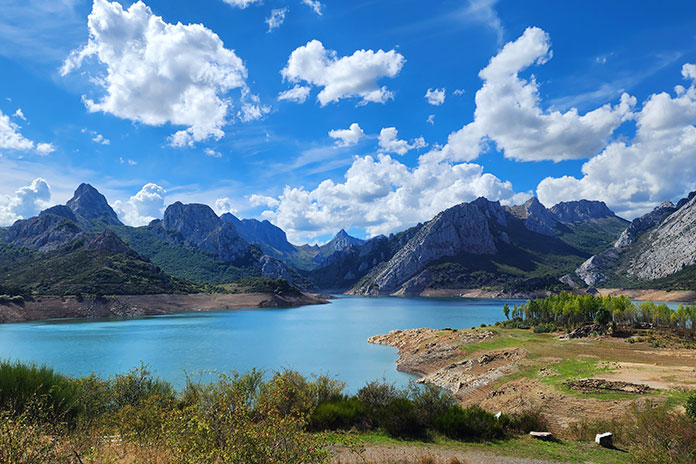
From cliffs overlooking the coast, we headed inland, where entertaining secondary roads wound us through agrarian landscapes past the hilly farms of Asturias. The most common crop appeared to be manzanas (apples), and most homes, even those that weren’t farmhouses, had a lemon tree in the yard. I admired the resilience of farmers here: There was hardly any land you’d call flat, yet orchards were abundant, tucked into every conceivable space. Livestock grazed along the roads here too.
Though the weather in northern Spain was mostly clear, warm, and dry, we rode through a late‑day rain shower near Oviedo, the bustling capital city of Asturias. On the last stretch to our hotel, it was useful having a guide with local knowledge and a solid plan to lead the group though wet, busy streets to the tight quarters of a downtown hotel parking garage. ¡Bien hecho, Juanan! Well done!
That evening in Oviedo, we had dinner in a sidrería (cidery), a pub‑like establishment where locals gather to drink cider, eat, and socialize. We enjoyed multiple courses of Asturian fare, washed down with sangría de sidra (cider sangria) made from the same variety of manzanas we saw growing on trees. It was an Asturian holiday, and patrons were joyously singing, their enthusiasm enhanced by pitchers of sangria. You don’t have to visit a museum to experience culture.
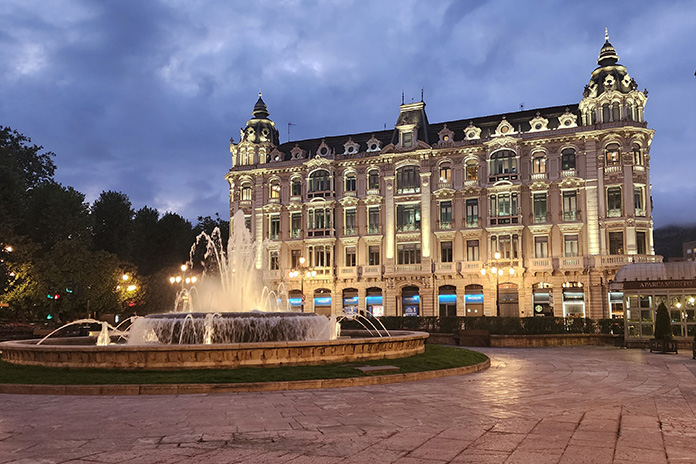
IMTBike scheduled a rest day halfway through this tour, but there was an optional lunch run to the seaside fishing village of Cudillero. Juanan led an exhilarating backroads jaunt through dense forest with little evidence of humans. Cudillero is built into rocky cliffs overlooking the Bay of Biscay. The ascending rows of colorful houses reminded me of similar towns I’d seen in Italy. At the edge of town, waves hitting the rocky shore presented spectacular views.
That evening, I decided to explore more of Oviedo on my own while speaking only Spanish. It had been decades since I studied Spanish in school, but after a few days in Spain, the fundamentals were coming back. I managed to buy a gift for my wife and order a fish dinner, celebrating these minor triumphs with una cerveza. ¡Salud!
Next morning, tour members huddled for our daily riders briefing with Juanan. He emphasized the need to depart the hotel as an organized group – and stay together as we left the city. A major bicycle race called La Vuelta, Spain’s version of the Tour de France, was passing through the area that morning. Juanan explained that the racecourse overlapped our route, and unless we rode through before race organizers closed the road, we’d have to wait. Thanks to this helpful attention to detail from our tour guide, our wellorganized group passed by the busy staging area for La Vuelta that morning on a still-open road.
After coffee, our route cut through Trubia River Gorge, where steep rock cliffs reached up on either side of us. Eventually we gained elevation, riding through the clouds until we poked above them into sunshine. I love when that happens. We crossed Alto de la Corbetoria Pass and then descended in tight curves to the Lena River to enjoy a stretch of easy sweepers to La Llama. The continuous flow of a curvy river road is always special on a motorcycle, and this tour included several of them.
Returning to the Picos de Europa, we relished technical curves and climbed in elevation before a lunch stop at Puerto de San Isidro, an alpine ski resort. At midday in late summer, skiers were notably absent. As our group prepared to move on, I let Juanan know I was going to ride alone for the afternoon. In this rugged and remote region of León, I stopped whenever I wanted to marvel at views of the mountains and lakes against a crystal blue sky. Since I opted for a GPS with routes pre‑loaded, it was no problem arriving on my own schedule (and well before dinnertime) at that night’s parador lodgings.
To build roads through northern Spain’s mountainous terrain, engineers have designed some impressive solutions. After a mid‑morning break in Potes, we reached Collada de Carmona Pass, where our mountain descent abruptly came into view. The road went through a hole cut through the cliff. Above the road, multilayer nets of steel mesh were moored onto the cliffside to catch falling rocks and held many they had snared. Then the road twisted down the mountainside, switchback after switchback, to the valley below. The smooth tar continued, snaking through positive camber curves along a meandering river for miles as the next mountain pass grew gradually closer. Up, over, and down again, the grin never left my face. At the next stop, our group of elated riders dismounted and exchanged high‑fives. What a run!
While winding roads with dramatic views earned my top score on this tour, architecture was a notable runner‑up. The ultra modern Guggenheim museum in Bilbao is a marvel of design, encased in a skin of titanium. In stark contrast, the Sanctuary of Loyola in Azpeitia was a grand example of Spanish baroque architecture. And with its classical civic buildings, elegant parkside homes, and captivating old town edifices, Oviedo was as pretty as any city I’ve visited.
By design, this tour put us on mostly empty roads. But on a warm, sunny afternoon in late summer, it was no surprise to encounter beach traffic along a scenic coastal route. The view of the seaside below was splendid from a gently curving road cut into the cliffside, and the tang of salt air scented every breath I took. A slower pace was fine for a bit.
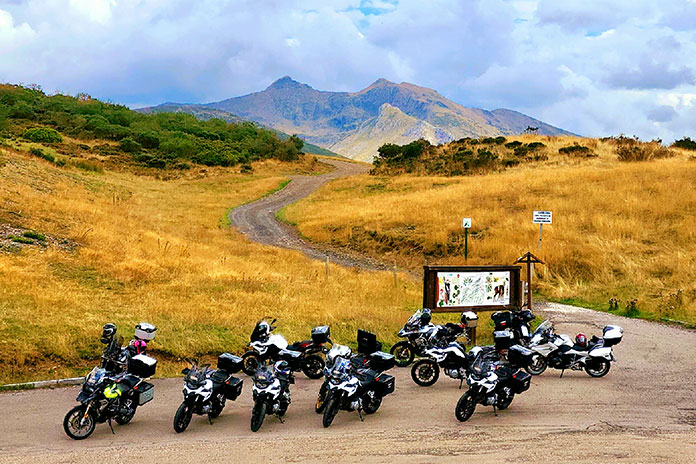
Then we found ourselves riding into the unexpected. An altered traffic pattern sent us into a congested cobblestone pedestrian zone where some kind of celebration was underway. Clearly, this wasn’t the plan. Folks were stunned by the arrival of a dozen motorcycles, but Juanan quickly calmed any concerns. The first few riders managed tight, bumpy U‑turns, but those farther back were squeezed into an alley. Juanan pivoted several of those bikes 180 degrees on the sidestand – first time I’d seen that technique used on cobblestones – and in short order, we rode off as folks smiled and waved.
Carving more curves through the Basque Country and down the steep hills into Bilbao, our tour came to an end where it began: IMTBike’s garage. We parked our bikes one last time as Juanan poured us a cava toast. Later, over our final dinner as a group, we relived favorite moments of this exciting tour and started planning more adventures.
In 2024, the Essence of Northern Spain tour runs June 29‑July 7 and Sept. 7‑15. Prices start at 3,845 euros (about $4,100 USD) for a single rider on a BMW G 310 R and sharing a double room. Larger motorcycles and private rooms are optional. Not included in the tour price are air tickets, lunches, gasoline, drinks, tolls, GPS, personal spending, and tips. Learn more at the IMTBike website.
See all of Rider‘s international touring stories here.

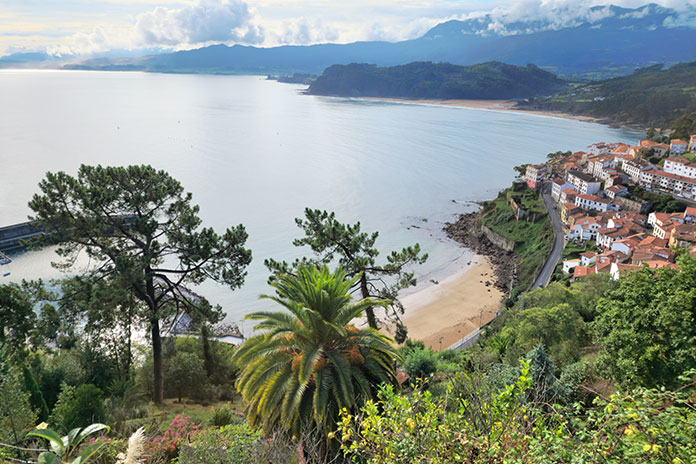

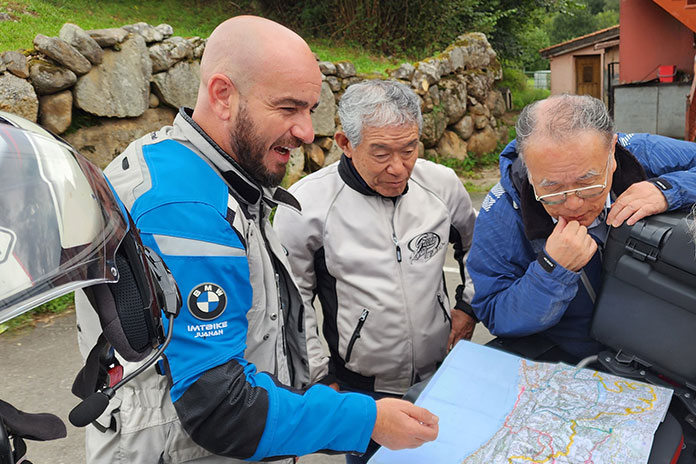

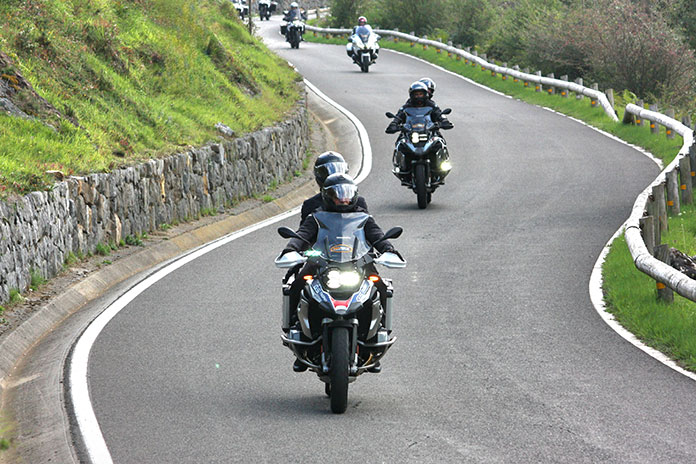



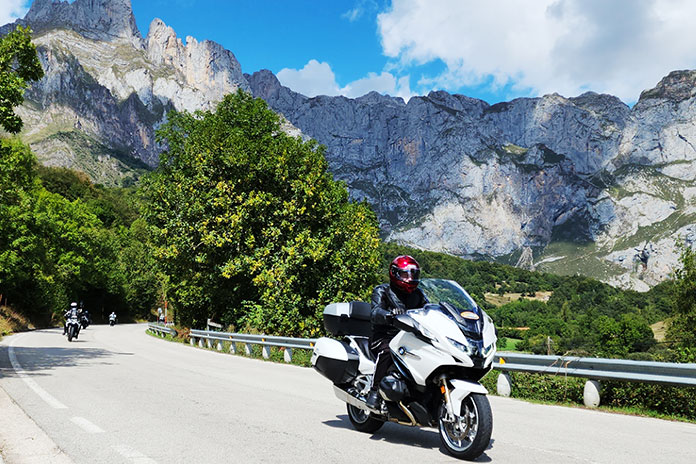







What a great article! Now I need to get some tapas and Rioja! Thanks for the visit.